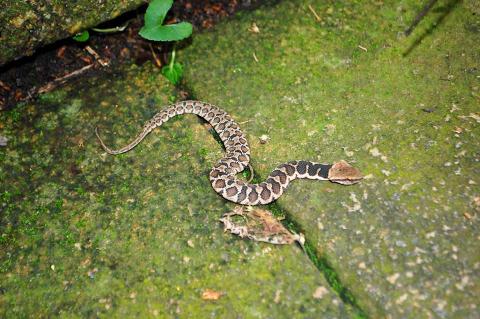A member of the public who was walking along a trail by Sun Moon Lake’s Cien Tower recently found a strange snake that looked like a Chinese sharp-nosed viper or a brown pit viper. The person was afraid that it was poisonous and took a photo as a record. When a snake expert was asked to look at it, however, it turned out to be a false viper.
The Endemic Species Research Institute in Nantou County’s Jiji Township says that although this kind of snake has characteristics of both the brown pit viper and the Chinese sharp-nosed viper, the eyes of the false viper have round pupils, unlike those of the brown pit viper’s eyes, which, like cats’s eyes, can vary in shape and appear oval in daylight conditions. In addition, the surface of a brown pit viper’s head is composed of small, fine scales, whereas on the false viper the scales are bigger. These features make it possible to distinguish between the two. It is normal for this kind of snake to be found at the Sun Moon Lake, which lies at a low-to-medium altitude, and it is a docile and non-venomous species of snake.
The Endemic Species Research Institute also says that if members of the public come across snakes in the wild, they should not frighten or tease them, but just walk slowly around them and leave. If people follow this advice, they will not be attacked by snakes.
(Liberty Times, translated by Clare Lear)

Photo provided by a member of the public
照片:民眾提供
近日有民眾在日月潭慈恩塔步道發現一條既像百步蛇又像龜殼花的怪蛇,民眾深怕有毒還拍照紀錄起來,經向蛇類專家請教才知是無毒的「擬龜殼花」。
集集特生中心表示,該蛇外觀雖有龜殼花與百步蛇的特徵,但在眼睛部分「擬龜殼花」瞳孔是圓的,不像龜殼花的瞳孔如貓眼一樣具可變性,白天呈現橄欖狀,另外龜殼花頭上都是細小鱗片組成,「擬龜殼花」的鱗片則較大,由此就能區分二者不同,該蛇在中低海拔的日月潭被發現實屬正常,且是溫馴無毒的蛇種。
此外,集集特生中心表示,民眾在野外發現蛇類,切勿驚擾逗弄,只要緩步繞道離開,就不會遭遇蛇類攻擊。
(自由時報記者劉濱銓)

Like people in many other countries, Taiwanese are fond of delicious fried snacks. For example, Spain is known for its churros, and in Taiwan there is a traditional fried dessert made of sticky rice called beh teung guai. The snack consists of sticky rice flour that is mixed with water, kneaded into a dough and shaped into small pieces. Once fried, the sticky rice balls are coated in crushed peanuts and sugar mixture. 世界上有許多國家愛吃炸甜點,台灣也不例外。舉例來說,西班牙有吉拿棒,台灣人則有油炸糯米的點心──白糖粿。作法先將糯米粉和水混合揉成糰,再捏成小塊,炸好後裹上花生糖粉。 knead (v.) 揉(麵糰、黏土),捏;捏製;揉捏形成 Beh teung guai is a traditional snack that has been enjoyed by many senior citizens since

WHEN ARE THE OLYMPIC AND PARALYMPIC GAMES? The Paris 2024 Olympics will run from Friday to Aug. 11, while the Paris 2024 Paralympics will be held from Aug. 28-Sept. 8. WHERE WILL THE GAMES TAKE PLACE? In September 2017, the International Olympic Committee (IOC) awarded Paris the 2024 Games when its only remaining rival, Los Angeles, agreed to wait another four years to be the host city. Paris has hosted two Olympics and will stage the event 100 years after its last Games in 1924. The Games will be staged in 35 venues across Paris, Ile-de-France, on both mainland France and overseas. Some notable venues

A: The 2024 Paris Olympics is set to open tomorrow (Saturday Taiwan time), and will run until Aug. 11. B: How many Taiwanese athletes will compete in the Olympics? A: About 60 Taiwanese athletes will participate in 16 sports. B: I’ve heard some Olympic gold medalists, such as weightlifter Kuo Hsing-chun, and badminton duo Lee Yang and Wang Chi-lin, will compete in the Olympics again. A: Asian tennis star Hsieh Su-wei, who is the World No. 1 in women’s doubles, is also on the Taiwan team. Let’s give our support to the Taiwanese players. A: 巴黎奧運自7月26日(台灣時間27日),至8月11日要登場啦。 B: 台灣有多少選手參賽? A: 台灣有60名選手參賽,將參加16項運動種類。 B: 這次奧運金牌舉重名將郭婞淳、羽球男雙李洋/王齊麟都會參賽。 A:

You might have seen athletes gracefully bending and leaping in rhythm with melodies. This is “rhythmic gymnastics,” a sport often mistaken for artistic gymnastics. However, the two are distinct in focus and presentation. Artistic gymnastics focuses on strength, flexibility, and balance, with athletes performing solo on various equipment. They are scored based on the difficulty of their movements, their execution of certain skills on each apparatus, and their ability to combine multiple skills into different movements. Rhythmic gymnastics, on the other hand, emphasizes style and presentation, with athletes often performing in teams. Moving in harmony with music, they use